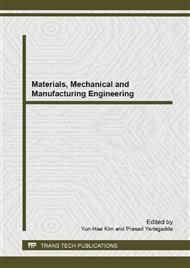p.591
p.596
p.602
p.607
p.612
p.620
p.624
p.629
p.634
Accurate Mathematical Model of Profile Curve Generated by Pre-Grinding Hob and Three-Dimensional Simulation of the Gear Generation
Abstract:
This paper illustrates a method to establish the theoretical equations of profile curve of gear teeth generated by the pre-grinding hob. Matrix computation and differential geometry are employed to derive the equations. Graphics of numerical examples based on the mathematical equations are interpreted using Matlab. The proposed model draws the conclusion about the proper parameters of the teeth profile for the optimization of hob design for industrial application. Furthermore, a three-dimensional model of the pre-grinding hob is built with Pro/E in parametric form as a supplementary approach. It is a descriptive-geometry-based method to generate the gear directly without mathematical derivation. By changing parameters that affect the geometry of a hob tooth profile the hobbing cutter can be constructed to generate any conjugated gear through the motion simulation. With the aid of exact mathematical model and computer program, efficiency of gear machining can be improved by eliminating the traditional trial and error procedure. Keywords-pre-grinding hob; antenna; differential geometry; theoretical equation; parametric design; simulation of generation.
Info:
Periodical:
Pages:
612-619
Citation:
Online since:
November 2013
Authors:
Price:
Сopyright:
© 2014 Trans Tech Publications Ltd. All Rights Reserved
Share:
Citation:


